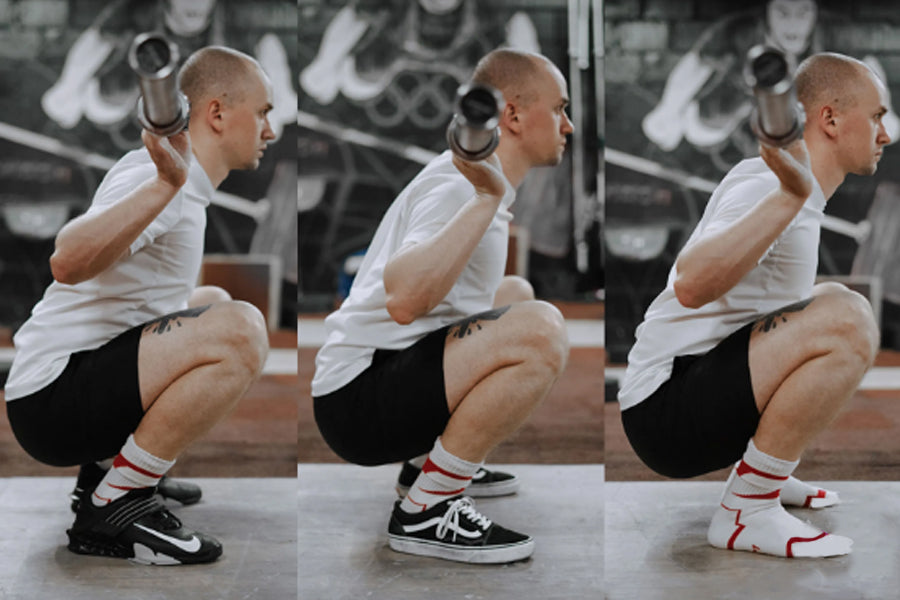If you're looking to up your squat game, the most brilliant move you can make is to find the proper squat for your goals. Barefooted or not, getting the most out of your squats means optimizing your squat type. Because squats are already pretty great, achieving those targeted results is even better.
Deciding between wearing shoes or going barefoot during a squat isn't just a fashion statement - it can impact your workout results. Each option has pros and cons, depending on what you're trying to accomplish in your training regime.
There's no one-size-fits-all answer here, but figuring out your goals and needs can help you make the best decision. So, take a step back, assess your priorities, and let your feet guide you toward the perfect squat.
Since squats are the master key to unlocking physical benefits, don't fret over whether you should leave your shoes on or off. However, paying attention to the details can sweeten the deal if you want to add some sprinkles to your workout.
Finding the right squat style for you can be the icing, so take advantage of its extra benefits! Get ready to learn the barefoot truth about shoe-wearing! This article can give you the lowdown on embracing the freedom of going sans shoes or the comfort of stylish sporting kicks.
If you are interested in watching a video instead of reading, here is a great video explaining the difference between lifting with training shoes, lifting shoes or being barefoot. Enjoy!
Does Squatting With or Without Shoes Matter

Lifters around the world know the importance of a good squat. Whether you prefer the classic barbell back squat, the elegant front squat, or the unique goblet squat, the principles are universal.
You can follow these principles for a healthier body, improved athleticism, killer quads, hamstrings, or both. So, squats are like snowflakes - no two are exactly alike. But when it comes to footwear, the consensus is that as your squat weight increases, so does the likelihood of keeping your shoes on.
Of course, there are always exceptions to the rule because isn't that just how life works? So, buckle up and read on to find out why squats and shoes sometimes don't mix.
When to Squat Barefoot
If you are tired of lifting weights with clunky shoes weighing you down? It's time to ditch the footwear and get barefoot for optimal benefits. But wait, there's more! Let's explore how going shoeless can enhance your performance and make you feel like a pro in the gym.
Here are some common conditions where barefoot is the way to go.
- If you've been feeling less stable during your squats, it's time to kick those shoes to the curb.
- If you are recovering from a foot or ankle injury.
- If you have tight hip muscles or ankle muscles.
- Ditching the footwear is acceptable if the floor has a solid grip.
Squatting Without Shoes Benefits

Who knew that your feet are such an incredible work of art? With 26 bones, 33 joints, and an army of muscles, your feet are superheroes in their own right. And remember your sensational side; feet are home to an army of sensory nerve endings that send signals to your brain like nobody's business.
So time to give a round of applause to your trusty foot soldiers and show them some appreciation for their daily hard work. Did you know that going barefoot can boost your foot muscles, joint flexibility, and sensory connection to your brain?
And the fantastic thing is that squatting without shoes on is the key to unlocking these benefits and keeping your tootsies in tip-top shape. So, you can say goodbye to clumsy movements and say hello to a stronger, more innovative, and more agile foot game.
Ankle Mobility

Do you know that squatting barefoot could take your ankle joints on a wild ride as your body has to go through a new range of motion called dorsiflexion, which is a fancy way to say your ankle joint is flexing in ways it doesn't usually do?
And that's not all - going barefoot squatting can also give your whole body a mobility boost, from your hips to your shoulders. Who knew that kicking off your shoes could lead to some severe gains?
Barefoot squatting can do wonders for improving your ankle mobility by pushing its range of motion to the limit with each rep.
Just remember to take it slow and avoid the temptation to go too deep so that you can not compromise your lower spine. As long as you avoid the dreaded butt-wink, your ankles can thank you for exposing them to a more excellent range of motion than your shoes ever could.
Full Body Mobility

Squatting is like walking a tightrope - one wrong move, and you could be plagued with lower back pain and injury. That's why it's crucial to keep your lower back in a strong and stable position by maintaining a flat posture.
Not only will this prevent harm, but it will also add some flexibility to your hip movement. So next time you hit the gym and go for a squat, make sure your lower back remains the star of the show!
Squatting barefoot might sound like a walk in the park, but it's not for the faint of the foot. If you're struggling to keep your torso upright or get deeper into your squat (without sacrificing your form), don't give up just yet!
By rising to the challenge and perfecting your technique, you can unlock a world of mobility you never knew existed. So kick off those shoes, and let's see what you're made of!
Improves Intrinsic Muscles of Foot

Let me introduce you to the unsung heroes of your feet - the intrinsic muscles! These little guys may be lesser known, but they are significant players in providing precise movement and control for your toes and the rest of your foot.
While they may get little attention, they are essential for keeping your feet healthy and functioning at their best. As you know that the longer you wear shoes, the weaker and less functional these foot muscles can become. If you are not walking around, you might not be giving your toes the necessary exercise.
For example, you slowly lose strength and flexibility if your shoes are stuck in the same position. It's like they're living in a tiny shoe prison, unable to express themselves fully. But it's more than comfort - neglecting your toes can weaken muscles and lack stability when walking or exercising.
Squatting can be one of the best ways to let your toes spread! So ditch your comfy rubber-soled shoes and get back to basics; you force your feet to work harder and strengthen those sneaky little muscles you didn't even know you had. It's like a workout for your foot!
Improves Proprioception of the Foot
Have you ever marveled at how your body knows where it is in space, even with your eyes closed? It's all thanks to proprioception, or your brain's ability to sense and understand the positioning, location, and forces that each body part is experiencing.
It's like having an internal GPS constantly updating your brain on your body's whereabouts. This sophisticated system is made possible by your nerves and muscles working together to gather all the necessary information and send it back to your brain.
It's like a well-oiled machine, quietly at work behind the scenes to keep you balanced and coordinated. Simply put, proprioception is your secret superpower! Did you know you can supercharge your proprioception in your feet and ankles by going barefoot or slipping into minimalist shoes?
Having your skin in direct contact with the ground can give your body even more sensory input to work with. So kick off those chunky sneakers and let your toes spread their proprioceptive wings.
Related Article: 10 Highly Effective Deadlift Alternatives for Beginners, at-Home Workouts, and More
When to Squat With Shoes-On
Let's dive into another topic that can flex your lifting knowledge and approach - the situations where you need to keep your shoes on for your lifts. Don't worry; we won't judge if you occasionally prefer going shoeless on a yoga mat, but lacing up may give you the added boost you need in these particular conditions.
So, let's get those shoes on and explore!
- If you know that your feet need structural support, such as from wearing insoles, orthotics, heel cups, etc.
- If you are lifting large, almost maximum, and maximum loads.
- If you are not willing to do deep squats.
- If you don't have time to constantly take them off and put them back on between exercises.
- If you're not feeling the barefoot workout vibes, there is no need to get your sweat on about it
Benefits of Squatting With Shoes-On

Take your time to dismiss the benefits of footwear for squats. While going shoeless may improve your form and activate specific muscles, remember the support and stability your trusty kicks provide. Now let's see how squatting with shoes on can be the game changer.
Maximizes Stability
Are your squats feeling unstable? Fear not; it's time to bring in the reinforcements. Adding support underneath and around your feet can make your squats shaky to stable. Let not those wobbly toes hold you back from maximum gains!
And if you are feeling like your feet are betraying you, here's a hot tip: arch support might be the solution. Whether you choose a custom-fitted option or an excellent over-the-counter choice, slipping on some supportive shoes can give you the confidence and stability you need to crush your workout.
So, lace up those kicks and squat like nobody's watching!
Maximizes Floor Friction
If you've ever hit the gym, you know how much sweat can damage your workout. And if you've ever suffered from sweaty feet, you know how much of a struggle it can be to keep them in place during squats. One missed step, and you can be out for the count.
Likewise, when it comes to squatting at the gym, the surface you're standing on can make all the difference. So, if you're slipping and sliding all over the place, don't worry - shoes are here to save the day.
Assists With Mobility Deficit

Getting deep into a squat can be a real struggle, especially if your ankle mobility could be better. You see, there's a little joint called the talocrural joint responsible for allowing your foot and ankle to move in all sorts of fancy ways when squatting.
And the deeper you go, the more this joint needs to flex and bend. But you can run into trouble if it's as stiff as a board. You might find your body compensating in weird ways. So don't let your ankles hold you back. While barefoot squats are all the rage, wearing shoes with a raised heel can work in your favor.
You can focus on form and depth without overcompensating by reducing the amount of ankle and foot movement required during the exercise.
Related Article: How to Create the Ultimate Home Gym
The Bottom Line
Whether going barefoot or rocking some fancy shoes, each style has pros and cons. If you opt for barefoot squatting, you can improve those foot muscles and boost your joint flexibility and sensory connection with the brain. Not to mention, it's a great way to show off your ankle mobility and proprioception skills.
On the other hand, shoes can provide added stability and grip when repping out those heavy loads or if your ankle mobility is a bit restricted. So, when choosing between barefoot or shoes for squatting, you must consider your goals, safety needs, and comfort levels. And no matter which way you go, get ready to feel the burn and crush those squat goals!











